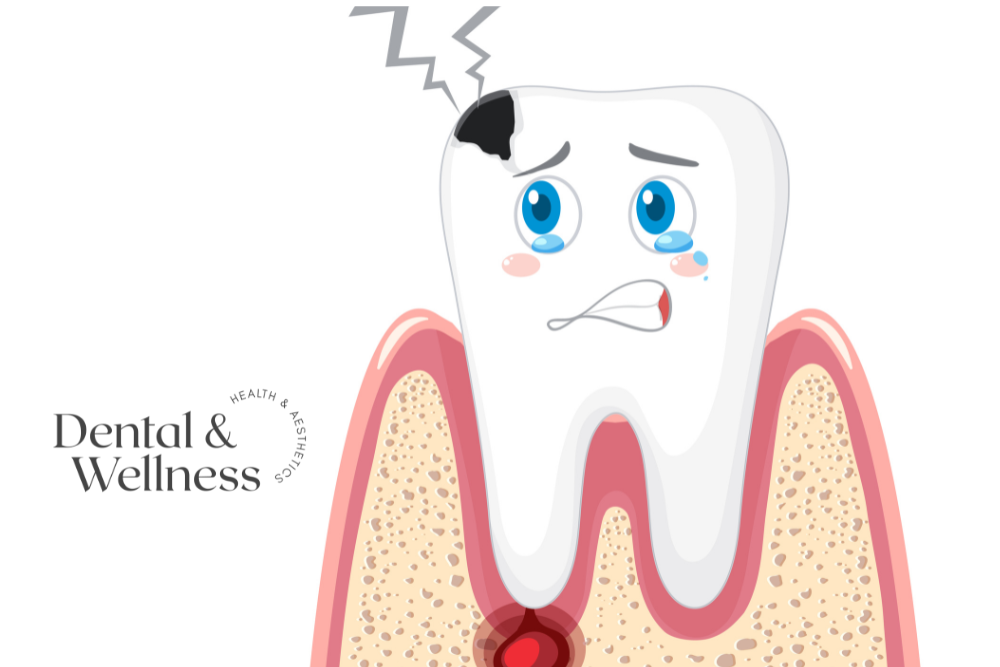- A tooth abscess is a pocket filled with pus caused by bacterial infection.
- It occurs in different stages, each with different symptoms that help determine if the infection is spreading:
- Early Stage: The infection is present within the tooth structure
- Middle Stage: The infection spreads to the deeper pulp layer
- Advanced Stage: The infection spreads beyond the tooth to the face, neck, and jaws
- Symptoms like face and neck swelling, fever, chills, body pain, and pus discharge from an abscessed tooth require immediate attention.
- If a tooth abscess is not treated on time, it can lead to serious complications.
- Treatments include:
- Abscess drainage
- Root canal therapy
- Tooth extraction
- Antibiotics
How to Tell if Your Tooth Abscess Infection Is Spreading
A tooth abscess occurs when bacteria infect the inside of the tooth, creating a pocket of pus. At first, the pain is usually felt only around the affected tooth, but if not treated, it can worsen over time. The swelling and irritation can spread to nearby gums, cheeks, or even the jaw. Understanding the tooth abscess stages is important because that is when you can notice changes before the infection grows more serious.
When the infection spreads, it may cause fever, tiredness, or difficulty swallowing. These signs show that the problem is moving beyond just the tooth. Knowing what to watch for can help prevent major health risks. The purpose of this article is to explain how a tooth abscess infection spreads and when to seek dental help.
What are the Stages of a Tooth Abscess?
To understand when an infection is spreading, you first need to know about the tooth abscess stages:
- Early Tooth Abscess Stage: Initial Bacterial Invasion and Inflammation
A tooth abscess starts when bacteria enter the tooth through a cavity or crack in the enamel. In the early stages of an abscessed tooth, the infection develops in the pulp, which is the soft tissue inside the tooth. The bacteria cause inflammation inside the tooth, which can slowly worsen if left untreated.
- Middle Tooth Abscess Stage: Pulp Necrosis and Abscess Formation
As the infection grows, it spreads deeper inside the tooth. The pulp dies (pulp necrosis), and the bacteria move toward the root of the tooth. This is when a pocket of pus begins to form around the root area. The infection starts to push against the surrounding gum and bone.
- Advanced Tooth Abscess Stage: Spread to Surrounding Tissues
If the infection is still not treated, the abscess grows bigger. The pus spreads beyond the tooth root to nearby tissues in the gums, jawbone, or even into the face. The infection may begin to affect other parts of the mouth or body if it continues spreading.
Signs That the Tooth Abscess Infection Is Spreading
Tooth abscess symptoms can appear suddenly and tend to become more severe as the infection progresses. Signs that it may be spreading include:
- Persistent, throbbing tooth pain that intensifies over time
- Swelling in the gums, face, or jaw near the affected tooth
- Red, inflamed gums that feel tender to the touch
- Sensitivity to hot, cold, or sweet foods that wasn’t present before
- A bad taste in the mouth or foul-smelling breath
- Fever, chills, or a general feeling of being unwell
- Swollen lymph nodes around the neck or under the jaw
- Difficulty opening the mouth or chewing comfortably
- Pain or discomfort radiating to the ear, neck, or head
- In severe cases, trouble swallowing or breathing

Serious Complications of a Spreading Tooth Abscess Infection
When a tooth abscess spreads, it no longer affects just your mouth. It can reach the bloodstream or airways. At this advanced stage, the risks can be dangerous.
The complications of an abscessed tooth are:
- Sepsis: Infection enters the blood, which can be life-threatening without urgent care.
- Ludwig’s Angina: A deep neck infection that causes swelling and breathing problems.
- Sinus Infection: The infection may spread to the sinus cavities near the upper teeth.
- Osteomyelitis: Infection spreads to the bone, weakening it and causing prolonged discomfort.
When to See a Dentist Right Away?
Experts at Dental & Wellness, London, can diagnose the issue before it spreads too far. Waiting too long will make the infection harder to treat.
If you notice the following signs and symptoms, visit a dentist immediately:
- Pain anywhere on your face or mouth should be examined as soon as possible by a dentist.
- Swelling in the face or jaw that keeps getting worse
- Fever higher than 100.4° F (38° C)
- Severe toothache that medicines cannot control
- Difficulty breathing, swallowing, or opening the mouth
- Pus oozing from the gums or tooth
.png)
Types of Tooth Abscess Treatment
Treatment depends on which stage the infection has reached. Here are the most common options:
- Draining the Abscess: The dentist makes a small opening to release pus and reduce pressure near the affected area. Only suitable for some cases.
- Root Canal Therapy: The infected pulp inside the tooth is removed using special instruments and replaced with a crown. This helps save the tooth structure. Again all these treatment options are chosen case by case basis to ensure that any treatment that is carried out is going to work with patients tooth situation, general oral health situation, lifestyle, simple choice and finances.
- Tooth Extraction: If the tooth cannot be saved, it is removed to stop the infection from spreading.
- Antibiotics: Medicines are given to kill the bacteria when the infection has spread beyond the tooth.
Conclusion
A tooth abscess is a pocket of pus caused by a bacterial infection inside or near a tooth. If left untreated, the infection may spread beyond the tooth, causing complications. Understanding the tooth abscess stages is important to know when to seek dental help.
In the early stage, you may experience tooth pain and sensitivity and notice a bad taste in your mouth. As the infection spreads to the middle stage, pain becomes sharper, and swelling near the tooth or gums may appear. In the advanced stage, the swelling spreads to the face and neck, making it difficult to swallow or open the mouth. At Dental & Wellness, London, experts offering dental care in Islington carefully assess these symptoms to stop the infection early and protect your oral health.
When an infection progresses, prompt attention becomes essential, which is why seeing an emergency dentist in Islington can prevent further complications. To ensure you receive immediate relief, we also offer same-day emergency appointments with a priority to alleviate your pain as quickly as possible.
For quick and trusted care, visit Dental & Wellness London at 222 Essex Road, London N1 3AP, or call 020 8127 4567. You can also email reception@dentalskin.co.uk to book your appointment today!
FAQs
How to drain a tooth abscess at home?
It is not safe to attempt to drain a tooth abscess at home. Rinse with warm water and see a dentist quickly to avoid serious infection or complications.
What does an abscessed tooth look like?
An abscessed tooth usually appears as a swollen, red bump on the gums, often like a pimple. The area is painful, tender, and may have pus or a bad taste.
How to remove an abscessed tooth?
To remove an abscessed tooth, your dentist will first numb the area around the tooth. The infected tooth is then gently pulled out using special instruments after draining pus and cleaning the site. Follow-up care helps with healing.
Can a tooth abscess heal on its own?
A tooth abscess usually cannot heal on its own. It requires professional care to drain pus and remove infection. Without timely dental care, the infection can worsen and spread, causing serious problems.
















